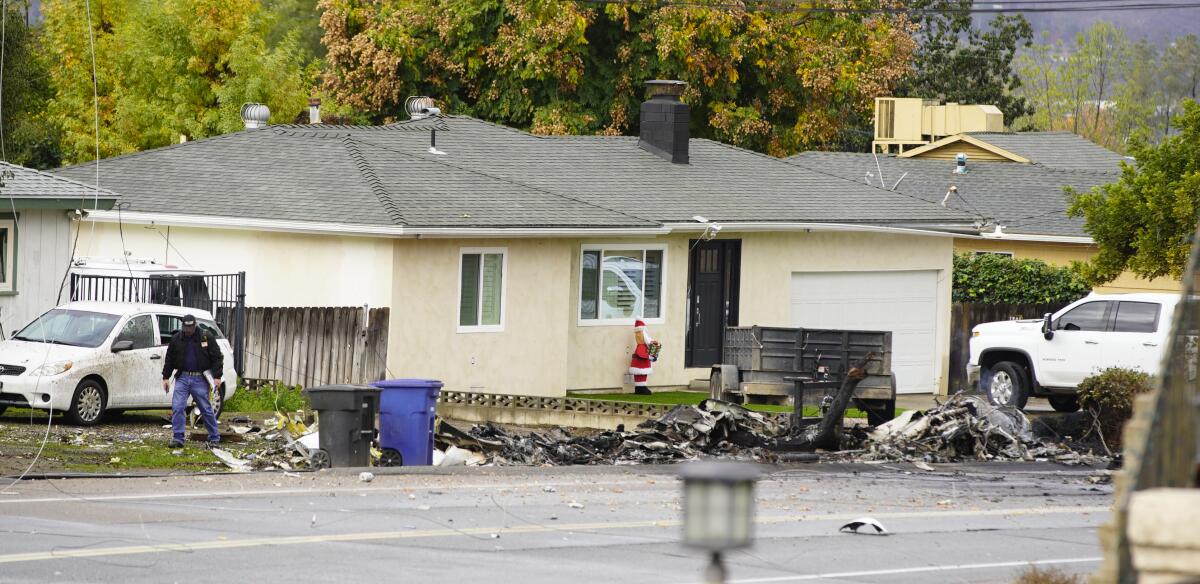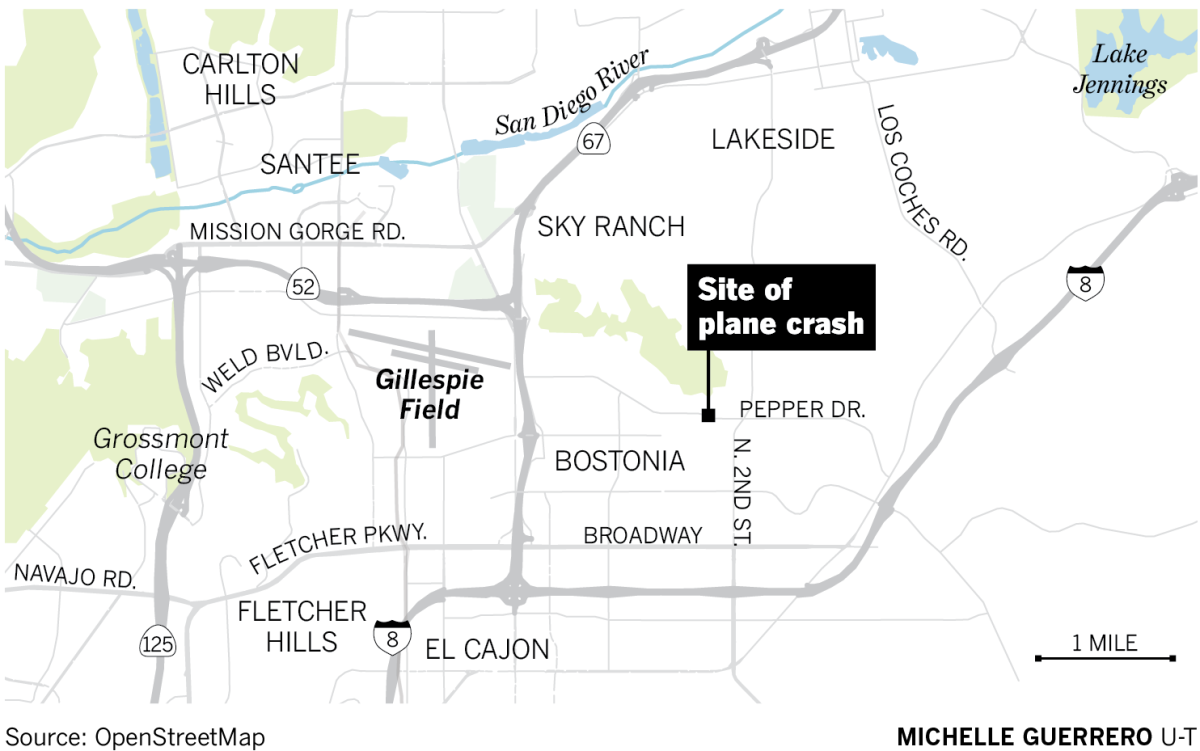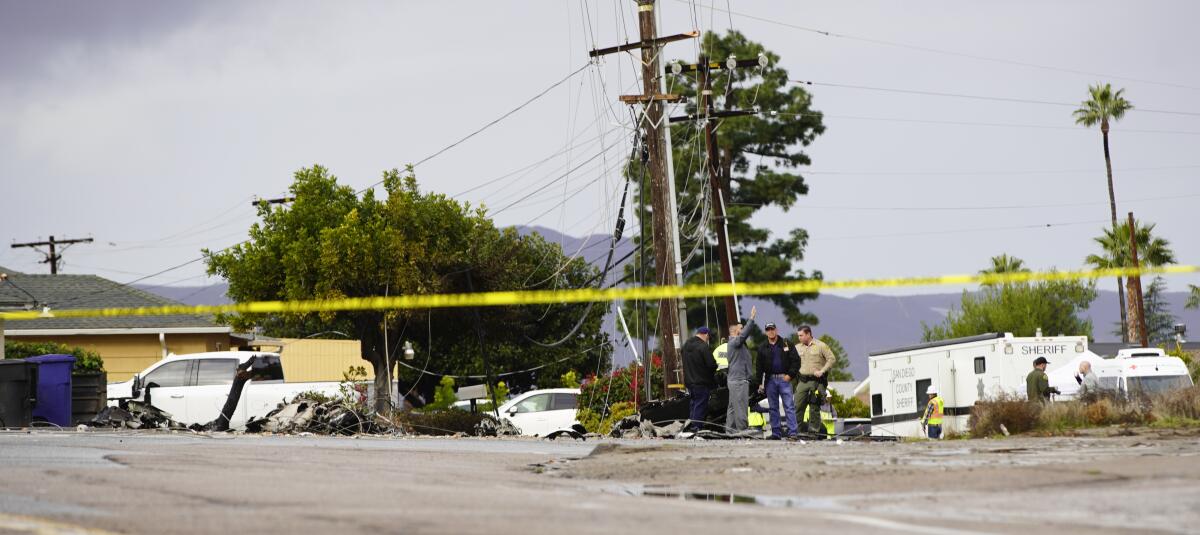Learjet attempted difficult approach at low altitude before deadly crash, records show

The Sheriff’s department says there were no survivors from a plane crash in a residential neighborhood near Gillespie Field on Monday.
- Share via
EL CAJON, Calif. — The pilot of a small jet that crashed in San Diego County on Monday night requested a change from an instrument reading to a visual approach on a different runway at the airport, the National Transportation Safety Board said.
A Learjet 35 business jet crashed and exploded in flames in an El Cajon neighborhood near Gillespie Field about 7:15 p.m. Monday less than 20 minutes after taking off from John Wayne Airport in Orange County. The plane took down several power lines, leaving thousands briefly without power, and damaged one home.
A two-person flight crew and two passengers were on the plane when it went down, Federal Aviation Administration officials said. All four — none of whom have been identified — were killed.
The FAA and the National Transportation Safety Board are investigating the incident and have not said what led to the crash. But an aviation expert who reviewed the plane’s flight path said it appeared the pilot tried to perform a difficult landing maneuver at a very low altitude shortly before the crash.
“If you strip apart everything else about the accident, the key is he appears to have been very, very low for what he was doing,” said Max Trescott, a flight instructor whose specializes in aviation safety. “It doesn’t make sense that he would have been that low under any circumstances.”

According to FlightAware, a flight-tracking website, the 10-seat jet registered to Med Jet LLC of El Cajon took off from John Wayne Airport in Santa Ana at 6:56 p.m. Monday. The plane climbed to about 11,000 feet before starting its descent to Gillespie Field in San Diego County.
On Tuesday, the NTSB said the plane had been on an instrument approach to Runway 17 at Gillespie Field.
“As the airplane neared the airport environment, the pilot requested a change to a visual approach to Runway 27R,” an agency spokesperson said.
In chilling air-traffic control audio posted to YouTube, a pilot aboard the small jet can be heard cursing and then screaming moments before the crash.
Trescott, who runs Aviation News Talk, an aviation podcast, said because of Runway 27R’s position at Gillespie Field, the jet pilot would have performed a circling approach that is similar to a technique known as the circle-to-land approach. This landing maneuver involves descending onto a runway in a roundabout fashion and is considered riskier than a straight-in approach.
It’s unclear why the pilot chose to land at 27R instead of Runway 17, which would not have required a circling approach, but it could have been because of the weather, Trescott said. A light mist was falling that night, weather forecasts show, and the runways may have been wet. Runway 27R is notably longer than Runway 17, and, according to Trescott, the extra distance could have made landing on a slick surface easier.
Even if 27R was a better choice, the plane should have been a lot higher before making its way to the runway, Trescott said. Generally, at an airport like Gillespie, airplanes are flying at about 1,400 feet before starting their descent. Minutes before the crash, the jet was just over 700 feet, flight records show, which is exceedingly low, Trescott said.
Officials haven’t commented on why the plane was so low in the sky when it approached the landing strip.
Gillespie Field doesn’t allow pilots to make circle-to-land approaches using their plane’s instrumentation at night, so the pilot would have been required to make a visual approach, Trescott said. The night of the crash, visibility was about three miles, the bare minimum for a visual approach, according to Trescott.
Shortly before the crash, the pilot can be heard in audio recorded at the time of descent asking air-traffic control workers to “turn up the lights.” The workers explain that the lights are already “at 100 percent.”
According to the NTSB, “shortly after air traffic control had cleared the airplane to land on Runway 27R, the airplane crashed into a residential area about 1.4 miles from the approach end of the runway.”

Video shot by OnScene.TV showed the smoldering wreckage in the middle of the road, most of it destroyed. Parts from the plane, including landing gear, were strewn across the street. The morning after the crash, debris remained scattered across the neighborhood streets.
Jessica Paredes, who lives near the site of the crash, said she and her family were watching TV in the living room when they heard a loud, rumbling engine sound — so loud it sounded like it “was inside my eardrum” — and she knew a plane was about to crash.
“When I heard the plane, all that came to mind was, ‘We are going to die; we are not going to make it out,’” she said.
She said everything went black, and then flames engulfed the street.
“That’s all you saw was flames everywhere,” she said.
She and her fiance got her 6-year-old son, who has physical disabilities, and 13-year-old daughter out of the house — but then she had to go back inside to find her car keys.
“It looked like the whole world was on fire at that point,” she said. And then they started hearing explosions.
By the time she got the car started, she had to drive through fire in order to get her family out.
“I’m terrified of fire,” she said. “My fiance said, ‘You have to go; you have to gun it.’”
She said she was able to get some things out of her house Monday night. Her family stayed overnight with her mother, and she was looking for temporary lodging that would accommodate them and their dog. She wasn’t sure when the power would be back on and was unsure if her house had been damaged.

Monday’s crash was the second deadly plane crash in less than three months in the eastern part of San Diego County. On Oct. 11, a Cessna C340 crashed on a residential street in Santee, killing the pilot and a UPS driver whose truck was hit by the plane.
Sheriff’s officials said the San Diego County Medical Examiner’s Office would be identifying those killed in Monday’s crash.
According to the NTSB, which tracks all flight-related crashes in the country, more than 8,200 aircraft have crashed in California since July 1962.
Data show 170 occurred in the San Diego area, and 64 list Gillespie Field as a destination or departure airport. NTSB data show 11 of the crashes related to Gillespie Field resulted in 19 fatalities, and nearly a dozen caused minor or serious injuries.
Staff writer Lauryn Schroeder contributed to this report.
More to Read
Updates
9:54 a.m. Dec. 29, 2021: This story was updated with new information.
Sign up for Essential California
The most important California stories and recommendations in your inbox every morning.
You may occasionally receive promotional content from the Los Angeles Times.












